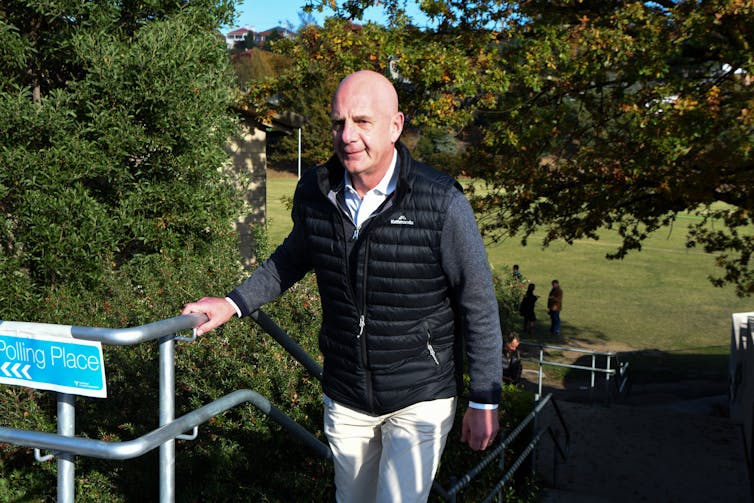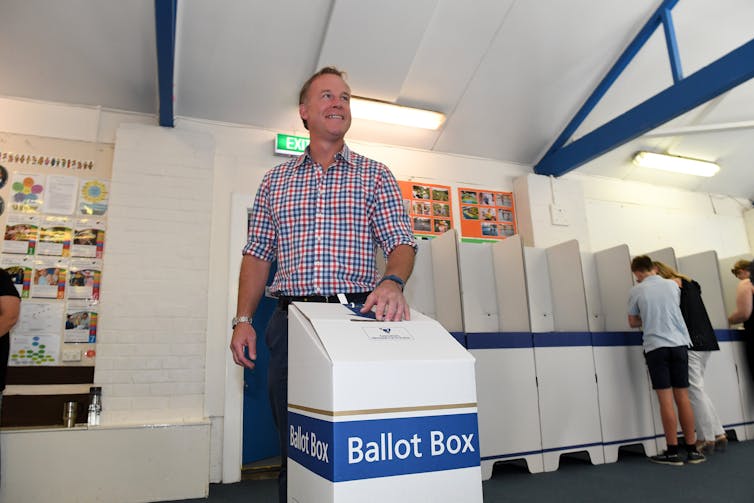
AAP/Mick Tsikas
Adrian Beaumont, The University of MelbourneThis week’s Newspoll, conducted May 13-16 from a sample of 1,506, gave Labor a 51-49 lead, unchanged from the last Newspoll published three weeks ago. Primary votes were 41% Coalition (steady), 36% Labor (down two), 12% Greens (up two) and 2% One Nation (down one). Figures are from The Poll Bludger.
58% were satisfied with Scott Morrison’s performance (down one), and 38% were dissatisfied (up one), for a net approval of +20. Anthony Albanese’s net approval was down four points to -7, his worst ever net approval. Morrison led Albanese as better PM by 55-30 (56-30 three weeks ago).
Newspoll has asked three questions after every budget: whether the budget was good for the economy, good for you personally, and whether the opposition would have delivered a better budget. Results for this last question are yet to appear, and it would be disappointing if that question has been cancelled.
44% thought last Tuesday’s budget was good for the economy and 15% bad, for a net rating of +29. On personal finances, 19% thought it would be good and 19% bad, for a net zero rating. Voters have consistently been better disposed to budgets on the economy than the personal.
The Poll Bludger says this budget is the eighth best on personal finance and the sixth best on the economy since Newspoll started asking these questions, which I believe was in 1988. Analyst Kevin Bonham says this budget has the best net score on the economy since 2007’s +48. However, the Coalition under John Howard lost the 2007 election after that budget.
Most budgets have little impact on voting intentions, and this is confirmed by voting intentions remaining unchanged on two party preferred in this Newspoll. Exceptions were the very unpopular 1993 and 2014 budgets. After both those budgets, the government lost much support.
The drop in Labor’s support, and the rise for the Greens, is probably due to left-wing voters who are unhappy with Albanese. Morrison’s consistently big lead over Albanese as better PM likely encourages some voters to perceive Labor would do better if led by someone more left-wing than Albanese. I posted about the flaws in this logic in my last Newspoll report.
In an additional Newspoll question, 73% thought Australia’s borders should remain closed until at least mid-2022, or the pandemic is under control globally. Just 21% thought borders should open as soon as all Australians who want to be are vaccinated.
In last week’s Essential poll, taken before the budget, Morrison’s net approval surged to +26 from +17 in mid-April. With women, his net approval rose 17 points to +21; with men, it was up two points to +31. While there is still a gender gap, many women appear to have forgotten or forgiven the sexual misbehaviour in March.
Liberals win Tasmanian majority as sex-compromised Liberal wins, then resigns
At the May 1 Tasmanian election, the Liberals won 13 of the 25 lower house seats (steady since the 2018 election), Labor nine (down one), the Greens two (steady) and Independent Kristie Johnston won the last seat. Vote shares were 48.7% Liberal (down 1.5%), 28.2% Labor (down 4.5%), 12.4% Greens (up 2.1%) and 6.2% for independents.
In party terms, there were two electorates where the result appeared uncertain in my post-election article: Clark and Bass. With five seats per electorate, a quota is one-sixth of the vote, or 16.7%. In the Hare-Clark system, candidates compete against other candidates in the same party, as well as other parties’ candidates.
In Clark, there was some doubt on election night as to whether the Liberals would win a second seat. But former Labor MP Madeleine Ogilvie, who had sat as an independent in the last parliament, and joined the Liberals at this election, won the second Liberal seat in Clark.
Ogilvie was 342 votes or 0.03 quotas ahead of fellow Liberal Simon Behrakis at the second last count. At Behrakis’ exclusion, final standings were Ogilvie 0.95 quotas, Johnston 0.93 and Independent Sue Hickey 0.82. Ogilvie and Johnston were elected to the final two seats.
In Bass, Labor benefited from leakage of Premier Peter Gutwein’s surplus and preferences from other sources. Labor easily defeated the Greens and Liberals for the final seat for a three Liberal, two Labor result.
The day before the election, Liberal Braddon candidate Adam Brooks was accused of impersonating to enter a sexual relationship using a fake driver’s license. Tasmania still requires early voters to complete a declaration that they cannot vote on election day, so most votes were cast on election day.
Brooks was still elected after a close race with two other Liberals in Braddon. With the final two seats to be filled, Jaensch finished on 0.934 quotas, Brooks 0.931 and Ellis 0.904, with Ellis missing out. Brooks had been 0.046 quotas ahead of Ellis after Liberal exclusions and surpluses, with his lead reduced by sources outside the Liberals.
Read more:
Has a backlash against political correctness made sexual misbehaviour more acceptable?
The Braddon result was finalised Thursday. On Friday, Brooks resigned his seat after Queensland police charged him with firearms offences. Brooks’ seat will definitely go to a Liberal on a countback (not a byelection), likely Ellis. The Liberals will be relieved at not requiring Brooks’ vote to maintain a majority.
In the upper house, the Liberals gained Windermere from a retiring conservative independent, while Labor held Derwent. In Windermere, the Liberals defeated Labor by 54.1-45.9, from primary votes of 37.8% Liberal, 27.0% Labor and 21.3% for an independent. In Derwent, Labor defeated the Liberals by 55.7-44.3, from primary votes of 49.1% Labor, 40.9% Liberal and 10.0% Animal Justice.
The Tasmanian upper house has 15 single-member electorates with two or three up for election every May for six-year terms. Current standings are five Labor, four Liberals, four left independents and two centre-right independents.
Poll gives Nationals 51-49 lead for Saturday’s Upper Hunter (NSW) byelection
A byelection will occur in the NSW Nationals-held state seat of Upper Hunter this Saturday. This seat has been Nationals-held since 1932, but at the 2019 NSW election, the Nationals had their lowest primary vote of 34.0%. Labor had 28.7%, the Shooters 22.0% and the Greens 4.8%.
Excluding exhausting preferences, the Nationals defeated Labor by 52.6-47.4, with 24.2% of total votes exhausting under NSW’s optional preferential system.
A YouGov poll for The Daily Telegraph gave the Nationals a 51-49 lead over Labor in Upper Hunter based on respondent preferences. Primary votes were 25% Nationals, 23% Labor, 16% Shooters, 11% One Nation, 6% Greens and 10% combined for two independents. The poll was conducted May 11-13 from a sample of just 400.![]()
Adrian Beaumont, Honorary Associate, School of Mathematics and Statistics, The University of Melbourne
This article is republished from The Conversation under a Creative Commons license. Read the original article.




